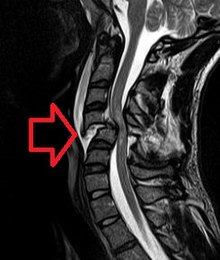User:Mr. Ibrahem/Neurogenic shock
| Neurogenic shock | |
|---|---|
| Other names | Vasogenic shock[1] |
 | |
| Cervical spine MRI showing a C4 fracture and dislocation resulting in spinal cord compression | |
| Specialty | Spinal surgery |
| Symptoms | Low blood pressure, low heart rate, warm skin, abnormal body temperature[1] |
| Complications | Organ dysfunction[2] |
| Duration | 4 to 12 weeks[3] |
| Causes | Spinal cord injury above T4, spinal anesthesia, Guillain-Barre syndrome, autonomic nervous system toxins, transverse myelitis, other neuropathies[2][1] |
| Diagnostic method | Based on symptoms and medical imaging after ruling out other possible cases[1] |
| Differential diagnosis | Spinal shock, hypovolemic shock, other types of circulatory shock[1] |
| Treatment | Intravenous fluids, C-spine motion restriction, norepinephrine[1] |
| Frequency | Relatively uncommon[4] |
Neurogenic shock is a type of shock due to spinal cord injury.[1] Symptoms may include low blood pressure, low heart rate, warm skin, and abnormal body temperature.[1] It starts at the time of injury and may last for 4 to 12 weeks.[3] Complications can include organ dysfunction.[2]
The cause is generally a spinal cord injury above the fourth thoracic vertebrae.[2] Other causes may include spinal anesthesia, Guillain-Barre syndrome, autonomic nervous system toxins, transverse myelitis, and other neuropathies.[1] The underlying mechanism involves loss of sympathetic tone.[1] It is a type of distributive shock.[2] Diagnosis is based on symptoms and medical imaging after ruling out other possible cases.[1] It differs from spinal shock, which refers to loss of sensation, reflexes, and motor function, though may be associated with neurogenic shock.[1]
The initial treatment is generally with intravenous fluids and C-spine motion restriction.[1] If this is not sufficient norepinephrine is often used to keep the mean arterial pressure greater than 90 mmHg.[1] The slow heart rate may be treated with atropine.[1] Surgery may be required to stabilize the spine.[1] Neurogenic shock is relatively uncommon.[4] It occurs in about 19% of cervical and 7% of thoracic spinal cord injuries.[1][3]
References[edit]
- ^ a b c d e f g h i j k l m n o p q Dave, S; Cho, JJ (January 2020). "Neurogenic Shock". PMID 29083597.
{{cite journal}}: Cite journal requires|journal=(help) - ^ a b c d e "Shock - Critical Care Medicine". Merck Manuals Professional Edition. Retrieved 5 January 2021.
- ^ a b c Chhabra, Harvinder Singh (2015). ISCoS Textbook on Comprehensive management of Spinal Cord Injuries. Wolters kluwer india Pvt Ltd. p. 784. ISBN 978-93-5129-440-5.
- ^ a b Standl, T; Annecke, T; Cascorbi, I; Heller, AR; Sabashnikov, A; Teske, W (9 November 2018). "The Nomenclature, Definition and Distinction of Types of Shock". Deutsches Arzteblatt international. 115 (45): 757–768. doi:10.3238/arztebl.2018.0757. PMID 30573009.
